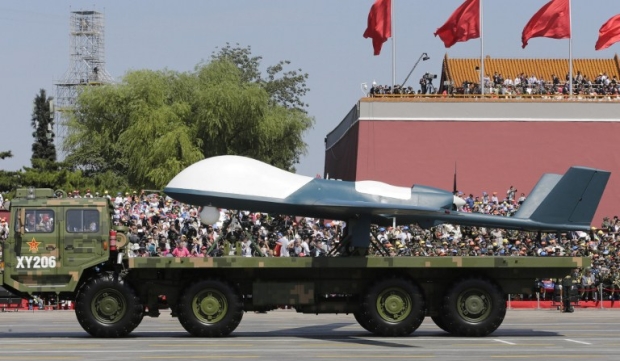China's Saudi drone factory compensates for US ban
China has struck a surprise deal to manufacture military drones at a factory in Saudi Arabia.
It forms part of a suite of agreements totalling $60bn agreed during King Salman's visit to the country last month that will also see the two countries develop oil refineries and co-operate on China’s Chang E-4 moon mission.
The deal comes as Saudi Arabia and its Gulf neighbours continue an unprecedented rush for arms to cope with what they see as a number of counter-terrorism threats across the region.
Meanwhile, long-standing ally, the United States shows no sign of granting those countries access to its own military drone technology.
"For a long time, China and Islamic countries have respected each other and had win-win cooperation, and have created a model of the peaceful coexistence of different cultures," Xi said, according to China's Foreign Ministry.
The factory, China’s first in the Middle East, will produce state-owned China Aerospace Science and Technology Corporation's (CASC) CH-4 Caihong, or "Rainbow" drone as well as associated equipment, which would improve after-sales services for clients in the Middle East.
China plugs arms gap left by US
The conflicts in Syria and Yemen and the rise of the Islamic State (IS) group have led countries in the region to increase their arms imports by 86 percent over the past five years, accounting for 29 percent of global imports, according to the Stockholm Peace Research Institute.
Saudia Arabia has become the world's second-largest arms importer, yet the United States, its closest ally and main exporter of arms, refuses to sell its Predator and Reaper drones, which go only to a small number of European nations.
The Saudis also felt incensed when last December then-US President Barack Obama blocked an arms shipment to Saudi Arabia after concerns were raised in Congress over civilian casualties in the Saudi-led war in Yemen.
This is despite the US waging a controversial drone campaign to take out what it sees as suspected al-Qaeda targets in Yemen for more than a decade.
Saudi has since turned to China, which unlike the US, is not signatory to the international Arms Trade Treaty (ATT) and so has fewer restrictions on the sale of drone technology.
Chinese drones are cheaper too.
The CH-4 costs $4m while a low-end Chinese drone can cost about $1m. On the other hand, American Reaper drones can cost in excess of $17m. Added to this a slump in world oil prices and it's easier to see why the CH-4 has become the killer drone of choice for countries across the Middle East.
“The CH-4 has recorded outstanding performance in anti-terrorist attacks in Iraq, Yemen, as well as in Africa’s Sudan, Ethiopia and China’s neighbouring Pakistan,” Zhou Chenming, who previously worked for CASC’s drone-development subsidiary, told the South China Post newspaper.
“That’s why our Saudi friends are so interested in the drone cooperation project,” he added.
It is believed that Saudi Arabia and UAE have used it for airstrikes in Yemen. Last year the Iraqi defence ministry released a video of a CH-4 strike on a car belonging to alleged IS fighters in Iraq.
The CH-4 has a range of about 3,500km and can carry the AR-1 precision-guided missile that can hit a distant target with a margin of error of less than 1.5 metres.
At the launch last month of a report assessing the military and defence capabilities of countries around the world, John Chipman, director of the International Institute of Strategic Studies, was cited by AFP as saying that "an emerging threat for deployed Western forces is that with China looking to sell more abroad, they may confront more advanced military systems, in more places, and operated by a broader range of adversaries."
The report found that in terms of air power, "China appears to be reaching near-parity with the West".
China's growing role in Middle East
Despite Chinese arms accounting for less than one percent of Saudi Arabian arms imports, arms deals were central to the formalising of Saudi Arabian-Chinese relations.
In 1988, China sold $3.5bn worth of state-of-the-art nuclear-capable ballistic missiles to Saudi Arabia, and two years later the oil-rich kingdom cut-off diplomatic ties with Taiwan and formally recognised Beijing.
Despite its reliance on the region for oil, China has traditionally played little part in Middle East conflicts or diplomacy. This has begun to change, with China trying to get more involved in efforts to end Syria's six-year-old civil war, where Riyadh supports rebels fighting President Bashar al-Assad.
China has also offered support for Yemen’s embattled government, which is backed by a Saudi-led Gulf Arab coalition in a war against the Iranian-aligned Houthi movement.
But China will be mindful to tread a careful line as it also enjoys a close relationship with Iran.
One Beijing-based diplomat from a Muslim-majority country told Reuters that China was trying to play the role of “honest broker” in the Middle East, as it lacks the historical baggage of the Americans or Europeans.
Stay informed with MEE's newsletters
Sign up to get the latest alerts, insights and analysis, starting with Turkey Unpacked
Middle East Eye delivers independent and unrivalled coverage and analysis of the Middle East, North Africa and beyond. To learn more about republishing this content and the associated fees, please fill out this form. More about MEE can be found here.





